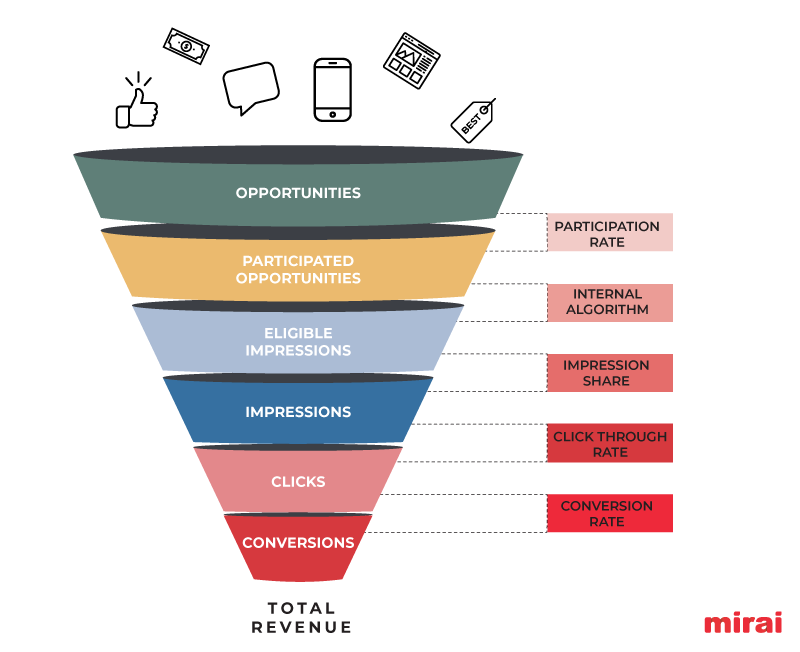This first post took a deep dive into each of the six areas in the metasearch funnel, explaining the most important variables in each step and their meaning.
NB: This is an article from mirai, one of our Expert Partners

Subscribe to our weekly newsletter and stay up to date
In this second post, we’d like to analyze the factors that affect each step in the funnel, the performance benchmarks you should aspire to, and how to identify areas for improvement and know what to do about them.
Let’s remind ourselves first about the six levels in the Google metasearch funnel: opportunities, participated opportunities, eligible impressions, impressions, clicks and conversions.
Opportunities
Opportunities reflect the demand for your hotel in metasearch engines. They mainly depend on your strategy and positioning. Demand can be divided into two types:
- Branded search:
– Frequent customers who already know about you. The more you work on your customer loyalty, the more searches you will generate for your hotel.
– New customers who have learnt about you from some source or other, or who have been recommended your hotel. The better your hotel is positioned in the most important sites (OTAs, review sites such as Tripadvisor or travel blogs), the more users will search for you by name.
– Customers who search for you after having seen an online or offline marketing campaign. The greater the reach of your campaigns, the greater the demand for your hotel.
- Generic searches, generally by location or concept. These searches mainly depend on the popularity of the location of your hotel or its “theme” (“hotel with wine cellar”, “hotel with spa”, “hotel for kids”)
Participation Rate
Unlike demand, your participation rate mainly depends on your inventory management and the quality of the partner providing your site integration.
- Lack of room availability or stay restrictions. If you have no rooms available, or apply too many restrictions, such as a minimum length of stay, your participation rate will be lower and you’ll miss a lot of the demand that your hotel needs for certain dates. You’ll also suffer the impact of not being able to respond to requests for long stays (Google allows stays of up to 30 days) or stays that are booked well in advance (Google allows you to upload prices up to 330 days in advance).
- Ability to display prices for different numbers of guests. Many companies that offer metasearch integrations only show prices for searches for two people in a room, not allowing searches for three or four people or searches that include children. This is vital in resort hotels, where this type of search can be higher than 30% of total demand.
- Ability to differentiate flexible rates. Again, it’s the responsibility of your integration partner to provide the ability to differentiate non-refundable rates from flexible rates, so that Google can respond if users apply this type of filter in their search. If you don’t have this functionality, you’ll be missing out on all this potential demand and lowering your participation rate.
- Landing page relevance. Your integration partner has to be able to set up your campaigns to support as many different combinations of languages, currencies and other features as possible to be able to respond to user requests. Very often there are certain currencies and languages that are not available, meaning more potential demand is lost along the way.
A good participation rate is one that is above 90%. Below that means that you’re missing out on potential demand and leaving many great opportunities on the table. This untapped demand will go straight to the OTAs.
Impression Share
Impression Share is the percentage that results from the number of times that your ad or organic search result is shown to users compared to your total eligible impressions. What factors have a direct influence on your Impression Share?





